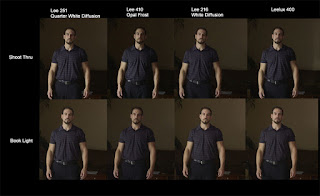Then I emailed my model/bodybuilder/SFX makeup artist friend Yoni Baker to use as a model to show the difference between the different diffusion types. Yoni and his physique often get cast as a barbarian or gladiator so this post was almost named "Conan the Diffuser", but that didn't seem very search engine optimized.
This was also a chance to break in the new Canon C100 that just came in on Wednesday. After fiddling with the controls for a few minutes we figured out how to set it in the correct modes, including using the wide dynamic range (WDR) profile to get all 12-stops out of the camera. I kept the ISO at 800 for easier metering with my Sekonic 758-cine light meter. The light meter doesn't read at Canon's native ISO 850 and I wanted to make sure that the exposure from the diffusion remained consistent. 800 was my nearest choice. You'll notice in the video below that the background exposure changes quite significantly. This is because the diffusion material absorbs and reflects different amounts of light. Also the book light tended to take up another stop of light in general.
There were two test configurations. First, a "book light" as shown in the picture below. Yes, I know the diffusion frame isn't obvious, but if you click on the picture you'll see it just to the right of light and directly hidden by the camera body. I used a piece of bead board sitting around the shop as a reflector, mostly because I forgot my bleached Muslin at home. It worked just as well. In the second configuration I simply blasted the light through the diffusion frame from about 5-6 feet away. The light is a Film Gear 575W HMI that was sitting on the show room floor and seemed like a reasonable choice.
The picture below shows all eight configurations of diffusion material and shoot-through/book light. In this particular configuration I didn't see much of any difference between 216 and Leelux 400. According to Lee's web site Leelux 400 has slightly stronger diffusion, but in practice there didn't seem to be a significant visual difference. Maybe with a smaller light fixture we might see a difference(?) There also wasn't a really significant difference in exposure metering.
The shadows seem to be deeper on 410 than on 251. You can see the difference in the shadow on his bicep and forearm. However, in the book light configuration there is only a slight change in diffusion from 251 to 261/400 and the metering is about the same. I'm guessing that the size of the source bounced off the bead board is starting to dominate the diffusion characteristic of the light at this point. 410 Opal Frost is still a bit more contrast-y with the book light, which is evident in the deeper shadow on his left cheek.
The video below shows Yoni moving around within the light so you can see how the light and shadows change. I also put the exposure settings for each test setup in the lower right of the video. This is just a reference so you can see how a diffusion material absorbs different amounts of light.
Yoni volunteered his time to model and occasionally show off his "mah-sev muh-sells" for this blog entry, so if you're looking for a model, actor, or special effects makeup artist here is a link to his Facebook page and Model Mayhem profile. I've spent many hours on set with Yoni I have to say that the guy does a perfect Ah-nold Schwarzenegger impression and can make anyone look like they took a ride through a blender with SFX makeup.
If you need more information please come in to see us at the shop. We're here to help...and check out our new Canon C100 in rental stock while you're there. We promise not to treat you like a "gurly-mahn."





Woh, this is awesome! Thank you so much.
ReplyDeleteNice, wish the photos were bigger, but the content was very informational.
ReplyDelete